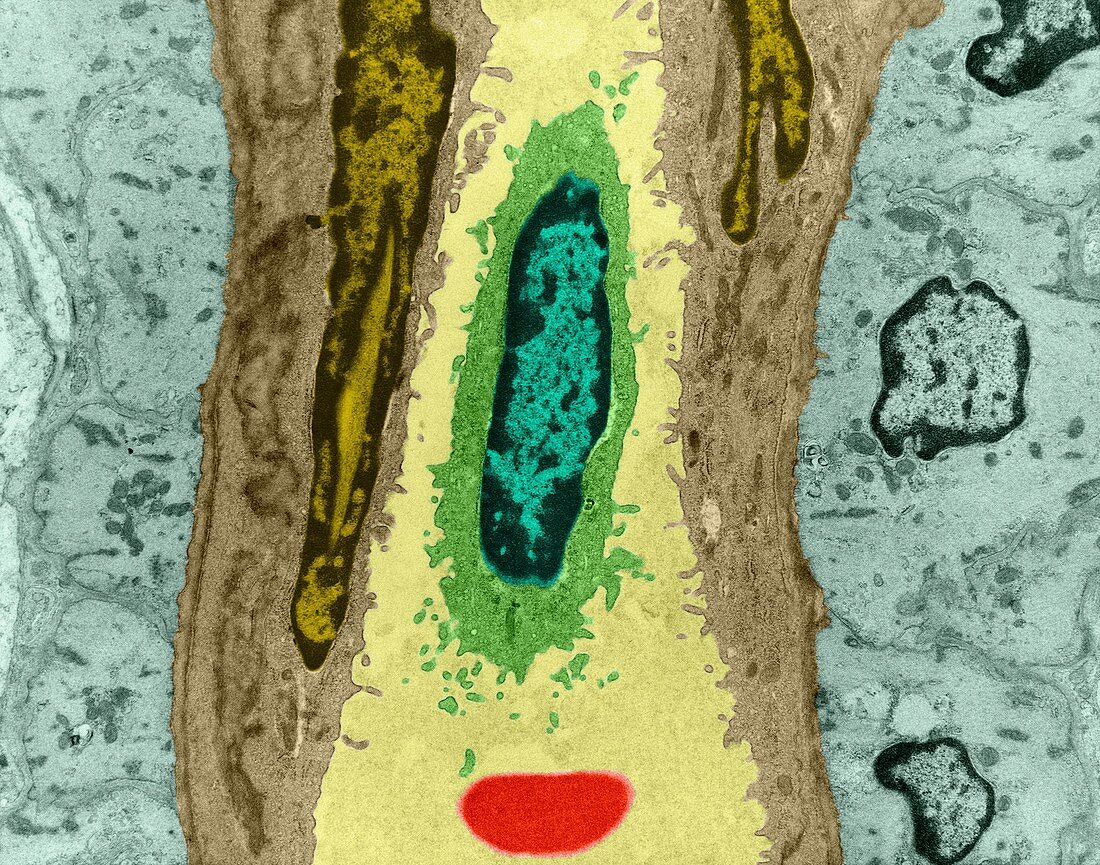White blood cell in capillary, TEM
Bildnummer 12298288

| White blood cell (lymphocyte) and red blood cell in a capillary (human central nervous system), coloured transmission electron micrograph (TEM). Red blood cells (RBCs), or erythrocytes, are the most common type of blood cell in vertebrates. They are involved in delivering oxygen to the body tissue. RBCs take up oxygen in the lungs or gills and release it into tissues while squeezing through the body's capillaries. The cytoplasm of RBCs is rich in haemoglobin, an iron-containing biomolecule that can bind oxygen and is responsible for the red color of the cells. In humans, mature RBCs are flexible and oval biconcave disks. White blood cells (leukocytes) are an important part of the body's immune system that protects against infectious organisms and foreign substances. Leukocytes are found throughout the body, including the blood and lymphatic system. Humans produce about 100 billion white blood cells a day. Magnification: x2, 135 when shortest axis | |
| Lizenzart: | Lizenzpflichtig |
| Credit: | Science Photo Library / DENNIS KUNKEL MICROSCOPY |
| Bildgröße: | 3333 px × 2622 px |
| Modell-Rechte: | nicht erforderlich |
| Eigentums-Rechte: | nicht erforderlich |
| Restrictions: | - |
Preise für dieses Bild ab 15 €
Universitäten & Organisationen
(Informationsmaterial Digital, Informationsmaterial Print, Lehrmaterial Digital etc.)
ab 15 €
Redaktionell
(Bücher, Bücher: Sach- und Fachliteratur, Digitale Medien (redaktionell) etc.)
ab 30 €
Werbung
(Anzeigen, Aussenwerbung, Digitale Medien, Fernsehwerbung, Karten, Werbemittel, Zeitschriften etc.)
ab 55 €
Handelsprodukte
(bedruckte Textilie, Kalender, Postkarte, Grußkarte, Verpackung etc.)
ab 75 €
Pauschalpreise
Rechtepakete für die unbeschränkte Bildnutzung in Print oder Online
ab 495 €
Keywords
- Atomkern,
- Blut,
- Endothel,
- Epithel,
- epithelial,
- Epithelien,
- Erythrozyt,
- Erythrozyten,
- farbig,
- gefärbt,
- Gehirn,
- kapillar,
- Kreislauf,
- Leukozyt,
- Lymphozyten,
- medizinisch,
- Mensch,
- menschlicher Körper,
- rote Blutkörperchen,
- tem,
- transmissionselektronenmikroskopische Aufnahme,
- weiße Blutkörperchen,
- weißes Blutkörperchen
